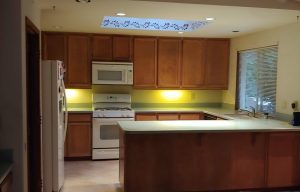You’ve decided to do some remodeling work in your home, but you’re not looking forward to the process. You’ve heard the horror stories from others who have survived a remodel, and you dread the possibility of similar things happening to you. Although there is inherent stress built into the process – and there’s probably no such thing as a completely stress-free remodel – below you’ll find 7 tips to minimize stress during a remodel.
As I mentioned in a recent post about my own home renovation after a kitchen flood, some things will happen that do not play out the way you wanted them to. With some mindset adjustments and a solid game-plan in place, you can get through the process with less stress than you might think. Here’s some advice from one who just went through it.
1. Articulate Your Goals and Priorities in Writing
Begin your remodeling project by writing down your goals and outlining a list of your top priorities. This will serve as an important guide you can refer back to as you make decisions throughout the remodeling process. Make your goals as clear and specific as possible so you can more effectively communicate with your contractors exactly what you want. This will also ensure that you and other decision-makers are on the same page.
 The priority list helps you communicate which aspects of your project are most important to focus on. If you need to make adjustments in order to fit your budget, this list will help you know where to cut and where to splurge.
The priority list helps you communicate which aspects of your project are most important to focus on. If you need to make adjustments in order to fit your budget, this list will help you know where to cut and where to splurge.
Anything you don’t understand about your home remodel project could derail your plans. Not knowing where to begin or how much everything will cost could paralyze your ability to make decisions. If you have a knowledge deficit, ask questions. I spoke with lots of qualified experts who were happy to share their wisdom, advice, and recommendations with me. These professionals helped me map out my remodeling plans, clarify priorities, and create a timeline.
2. Set a Realistic Budget
Budgets are necessary to stay within your means. Even with a budget, there will be unknowns and unexpected turns of events that arise. Your budget needs to be able to flex with these variables, even if you don’t know what they will be. Experts suggest adding a 10 – 20% buffer, depending on the scale of your remodel.
Smaller kitchen remodels, for example, might cost $15,000 – $35,000. To plan your buffer accordingly, you’ll need to create a line-item budget that includes the cost of materials and labor, listing everything you want to do. Then tack on an additional 10-20%.
Since I recently went through a kitchen remodel, I will share an example.  Once we determined that we were getting new cabinets, we decided to get new stainless-steel appliances and completely change our color scheme. One of the new appliances was an induction range, which required a 220-volt plug-in (my old gas range used 110-volt), which was included in the budget. I hired an electrician to put this in for us. While he was installing the 220-volt plug-in, he suggested that we upgrade our dull recessed lights with bright energy-efficient LED lights. The new light canisters and installation added another cost we had not budgeted for.
Once we determined that we were getting new cabinets, we decided to get new stainless-steel appliances and completely change our color scheme. One of the new appliances was an induction range, which required a 220-volt plug-in (my old gas range used 110-volt), which was included in the budget. I hired an electrician to put this in for us. While he was installing the 220-volt plug-in, he suggested that we upgrade our dull recessed lights with bright energy-efficient LED lights. The new light canisters and installation added another cost we had not budgeted for.
Although I would not have hired an electrician to make a special trip to our home to upgrade our lighting, I was so happy with the results in the kitchen that I decided to have our electrician install LED lights in several other areas of our home before he left. The difference has been amazing – from dull to bright overnight — and the additional cost was well worth it. We’d been complaining about the poor lighting in our home for years, especially during the cloudy winter months. Including a buffer in your budget will allow some wiggle room for these kinds of unplanned expenses.
Your budget may not be completely accurate, but do your best to include all possible costs. Remember to include the cost of any required permits and inspections from your local government. Think through any retrofits you might need (like a 220-volt outlet), as these additional costs can add up. And remember that there’s also sales tax on most things.
HomeAdvisor offers some great resources on their website to help you determine costs based on other recent home projects completed in your geographic area. They include both local and national cost data and they update this regularly to keep up with fluctuating costs of labor and materials. The most popular remodels are for bathroom and kitchen. HomeAdvisor offers cost data for many other remodeling projects, as well. I encourage you to access this data as a resource to help you create a realistic budget.
3. Carefully Select Who You Hire
This is a critical part of managing stress with a remodel. The first thing you’ll need to decide is if you will supervise the whole project yourself (be the General Contractor) or if you’ll hire that out to someone else and have them manage all the other contractors required to complete your remodel. You lose some control by having someone else manage it, but you need to be prepared for the fact that it’s very time-consuming to be the one managing it all.
 The General Contractor that our insurance company recommended was moving way too slowly for my liking, and I was told that it might take as much as five months before we’d have a functioning kitchen again. That timeline was not acceptable to me, so I decided to take charge of the whole project myself. I got it all done in nine weeks from start to finish.
The General Contractor that our insurance company recommended was moving way too slowly for my liking, and I was told that it might take as much as five months before we’d have a functioning kitchen again. That timeline was not acceptable to me, so I decided to take charge of the whole project myself. I got it all done in nine weeks from start to finish.
Whenever possible, get referrals from people you know and trust. Before you hire them, check their references and ask to speak with three most recent clients. Do your research and ask a lot of questions:
- Are the contractors and sub-contractors licensed and bonded? (You can find this information on the Internet.)
- Do they have a good rating with the Better Business Bureau?
- What kind of Yelp reviews do they have?
- Do they give firm estimates before the job begins?
- How often do they go over budget and by how much?
- What percentage of the total do they want to be paid up-front before the work is completed? (Never pay the full amount up front!)
- What is their track record for showing up on time and staying until the project is finished? (Contractors are notorious for beginning your project and then moving onto a more lucrative job before finishing yours.)
- Do they pay attention to the details and do quality work?
- How well do they communicate about adjustments in plans, cost overruns, timelines, etc.?
4. Manage the Schedule and Timeline
Create a detailed overview of the project. Mapping out a master plan is key to the overall success of staying on schedule. The schedule is more than just a start and end date. It needs to have a detailed timeline  including everything from start to finish. There is an order to doing things, so if one contractor gets off schedule, it can throw everything else off.
including everything from start to finish. There is an order to doing things, so if one contractor gets off schedule, it can throw everything else off.
In my case, I had a lot of moving parts and in most cases, I could not have the next contractor begin work until the previous contractor had finished their work. I made sure that each contractor knew the schedule, and how many other contractors’ schedules they would throw off schedule if they did not adhere to the timeline they’d committed to.
Again, there is an order to things. In our case, it all began with our insurance company assessing the damages. A water and mold mitigation company had to dry things out, and because they found asbestos, we had to have an asbestos abatement done before anything else could happen. Contents of the entire main floor had to be packed out and placed in a storage pod parked in our driveway. Damaged cabinets, drywall, and flooring had to be removed before the remodel could begin. Drywall and texturing had to be done before we could paint. Paint and electrical work had to be done before cabinets and appliances were installed. This was followed by the installation of flooring, then countertops, then plumbing and finish work (floorboards, door frames, etc.). Once all that was done, we were finally ready to move back in.
I had to manage all of this carefully. For example, I had the plumber scheduled to install the faucet, garbage disposal, and instant hot water the day after the countertops were installed. There was a delay in the countertop and sink installation, so I had to reschedule the plumber since he could not do his work until those things were in place.
I learned the importance of being firm but kind. Expressing a little gratitude can go a long way in making others feel appreciated and valued, which in turn makes them want to be more accountable for following through with their commitments to you.
5. Negotiate, Compromise, and Be Flexible
You may have heard the old Buddhist saying, “The root of suffering is attachment.” Well, that rings true, especially during a remodel.  Amidst the excitement of getting something new that you may have been dreaming of for a long time, it’s easy to get fixated on the vision in your head of how things are supposed to be. Flexibility is really important here, as some plans may stray from their original path, and adjustments may need to be made.
Amidst the excitement of getting something new that you may have been dreaming of for a long time, it’s easy to get fixated on the vision in your head of how things are supposed to be. Flexibility is really important here, as some plans may stray from their original path, and adjustments may need to be made.
Don’t sweat the small stuff. Instead, keep the big picture in mind and be willing to flex a little on the details. You can hold onto your overall vision and avoid disappointment and heated disagreements by learning to negotiate.
Here’s another example from my kitchen remodel. I really wanted to replace my blind-corner kitchen cabinet with a lazy susan cabinet organizer. In order to have this installed, I needed to give up 6 inches of overhang where I’d previously had three bar stools at the kitchen counter. The owner of the cabinet company let me know that I had a choice: they could install the lazy susan, or they could install a blind-corner cabinet like I had before and maintain the 9-inch depth of the previous countertop overhang. Because of the limitations of the space we were working with, I could not have both. I decided to get the lazy susan I really wanted and reduce the depth of the overhang by six inches. I still have bar stools at the counter, but the overhang is very shallow.
6. Communication is Key
Any confusion or misunderstandings between you and your contractors may cause unpleasant disputes and added stress. Work with contractors who place a high value on honesty and transparency. I told my contractors, “Don’t tell me what you think I want to hear…just give me the facts.” Ask for regular progress reports and raise concerns immediately.
 One of the biggest sources of stress during my remodel was when I’d call a contractor and they would not call me back. I learned the importance of finding out how a contractor likes to be contacted. After leaving several messages for my painter and not receiving a response, I learned that he only replied to text messages.
One of the biggest sources of stress during my remodel was when I’d call a contractor and they would not call me back. I learned the importance of finding out how a contractor likes to be contacted. After leaving several messages for my painter and not receiving a response, I learned that he only replied to text messages.
I also discovered that there’s often a delay with cell phone voice messages, so sometimes my voice message to a contractor or their voice message to me had a delayed delivery time of as much as several days. (I did not have this issue with landline phones.)
I was grateful that the owner of my cabinet company was such a good communicator. Had he not mentioned the decreased countertop overhang depth beforehand, I would have been disappointed to discover after the counters were installed that I’d lost six inches of overhang. Because he gave me a choice, I got to decide what I would give up. I also had time to adjust my expectations before I saw the final product for the first time. In other words, there were no surprises.
Communication is also key with other members of your family who will be affected by the remodel or who are helping with the cost. Everyone needs to be kept in the loop about the timeline and how the remodel will affect them. Decision-makers need to be part of an ongoing budget discussion, especially with additional costs.
Perhaps the cost of your remodel is more than you and your spouse originally planned for. This is why it’s really important to be clear about your goals from the start. Is your remodel mostly cosmetic, or do you want to completely rework the structure and functionality of the space you are remodeling? For example, if new cabinets are not in your budget and your goals are to change the color scheme in your kitchen, you might decide to give them a facelift by learning how to refinish or paint your old cabinets yourself.
I’ll use another example from my own kitchen remodel. In our case, the lower cabinets were badly damaged by a kitchen water pipe burst, and our insurance company wanted to replace parts of the lower cabinets and reface the upper cabinets to match. After researching several cabinet companies, I found one that had a one-week turnaround time and they were able to replace all of our cabinets – upper and lower — for less than the cost of refacing them.
7. Have a Back-up Plan
You set a budget and worked through some small hiccups. Now comes a bigger bump in the road. It could be that your project timeline is taking longer than initially planned, or you ran into a significant setback. Now it’s time for Plan B. If this happens to you, you’ll be grateful that you had a backup plan and organized the essentials ahead of time.
Let’s say the worst-case scenario happens, and you need to find somewhere else to stay. Instead of scrambling last minute for a potentially pricey hotel room, have a backup plan arranged with nearby relatives or friends who will let you stay with them for a while. Additionally, remember to remove any sentimental or valuable items from your home. You don’t want to run the risk of unforeseen mishaps ruining your unreplaceable belongings or having them stolen with dozens of workers coming and going from your home.
 Lastly, relocate everyday items you’ll need to access to a convenient spot where they are easily accessible. Although we ate at a lot of restaurants when we had no kitchen, it was nice to have a makeshift kitchen set up that included things I held back from getting packed away, such as a coffee maker, blender and toaster oven. We also borrowed a small portable microwave from a friend, which made it possible for us to do more cooking and reheating without a kitchen.
Lastly, relocate everyday items you’ll need to access to a convenient spot where they are easily accessible. Although we ate at a lot of restaurants when we had no kitchen, it was nice to have a makeshift kitchen set up that included things I held back from getting packed away, such as a coffee maker, blender and toaster oven. We also borrowed a small portable microwave from a friend, which made it possible for us to do more cooking and reheating without a kitchen.
If you’re gearing up for a remodel and you’d like support in planning, organizing, and executing a reduced-stress experience, let’s schedule a no-cost, no-pressure Discovery Call today.
Additional Resources
- Blog: What Being a General Contractor Taught Me About Life
- Guide: Organize Your Home: A Road Map to Getting Your Home in Order in Just 30 Days!
- Guide: Your Guide to Preparing for Disaster — FREE













Love your helpful, great ideas…Thanks and of course love your remodeled kitchen…Looks beautiful👏👏🌹
Thank you, Sheida! I hope my own personal learning will save others some heartache when doing a remodel. I am enjoying my new kitchen and my new floors throughout the main floor of our home. It’s amazing what a difference this has made in my enjoyment of our home!